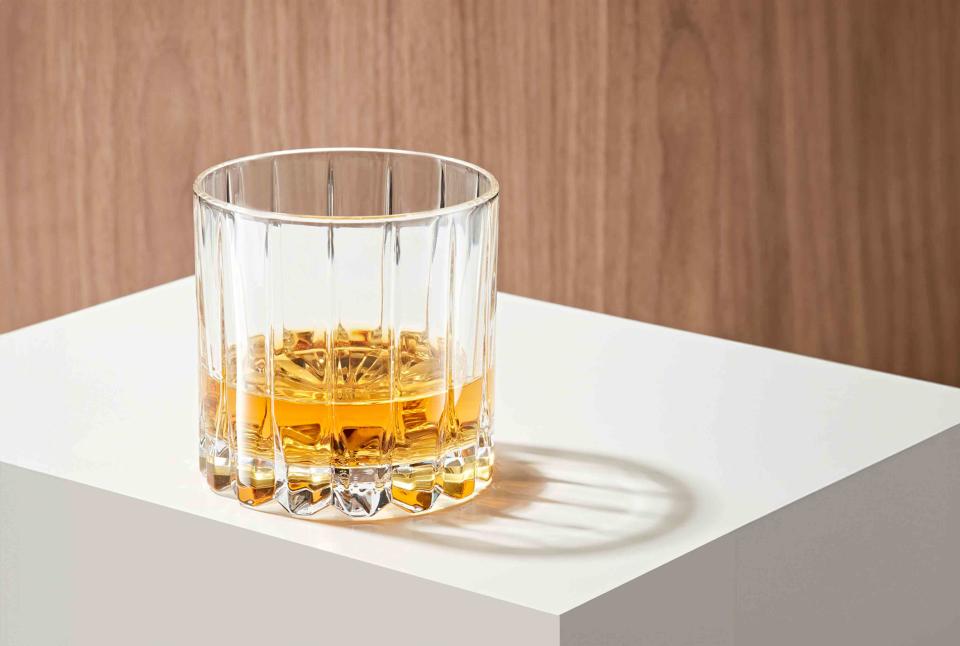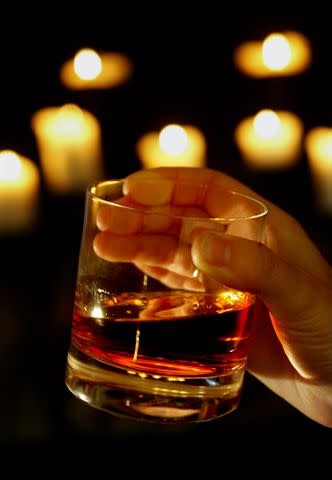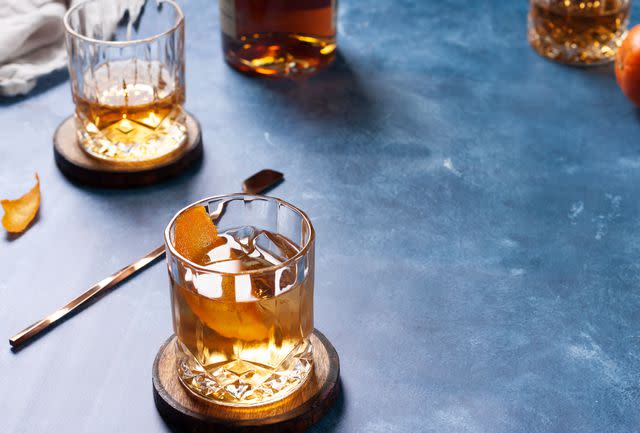Why People Love Bourbon So Much—Plus a Beginner's Guide to All the Ways to Enjoy It
Our guide to bourbon will have you reaching for your rocks glass or cocktail shaker in no time.

Shana Novak / Getty Images
Bourbon is the most American of spirits. It's also one of the smoothest, most approachable, easy-drinking whiskeys out there—and a great way to get into cask-aged, brown liquors. If you are intrigued but don't know where to start, our guide will explain what bourbon is and how it is made, including what the "angel's share" is. Also, find out what type of bourbon you need and how to pick the best bottles for stocking your home bar, sipping, and mixing into cocktails.
Related: What's the Difference Between Irish Whiskey and Scotch Whisky?
What Is Bourbon?
Bourbon is a member of the whiskey family of spirits, and it's a uniquely American whiskey. Just like Scotch is from Scotland and Champagne from France, bourbon must be produced in the United States. Fun fact: Although 95 percent of bourbon is made in Kentucky, it can be made anywhere in the country. In fact there are delicious bourbons made in all 50 states.
What Bourbon Is Made Of
Whiskeys are made from just three basic ingredients: grains, yeast, and water. This might remind you of the raw ingredients of another very popular beverage: beer. One easy way to think of whiskey is that it's essentially beer distilled to raise its alcohol content to the level of a spirit (more on that later).
Grains
While the spirits in the whiskey family are made from different types of grains, bourbon has one special requirement: the majority of grain used in the grain blend, also known as the mash bill, must be corn. So, while at least 51 percent or more of the bourbon mash bill is corn, the other grains are often a blend, including barley, wheat, and rye. Every bourbon brand has a different recipe for the mash bill; some keep it a secret, and some reveal their mash bill on their websites or at tasting events (it's very rarely, if ever, on the bottle's label).
Water
The type and quality of water used for making bourbon is just as important as the grain blend. Ideally, the water will be clear, pure, and free of minerals like iron. This is where you can truly taste the terroir, or sense of place, of a whiskey. Kentucky, where most bourbon is made, is abundant in limestone, influencing their water and, therefore, the finished flavor profile.
How It's Made
There are four steps to making bourbon:
Brewing: The corn-based grain blend is mixed with water and then heated to cook the grains (also called mashing the grains). This brewing process helps convert the starches in the grain into simple sugars.
Fermenting: Once there is easily accessible sugar, yeast is added to convert that sugar into alcohol (also known as fermentation). At this stage, we have, at the basic level, a beer.
Distilling: The beer-like mixture is then distilled, heating and cooling the liquid to evaporate water and focus the esters and alcohol.
Aging: The distillate is put into a brand-new charred oak cask for a minimum of two years. It is a legal requirement for bourbon to be aged in a new cask. Once aging is completed, most used bourbon casks are repurposed for aging other spirits or even wine and beer. Bourbon’s golden color and most of its flavor are developed during this aging process.
The Taste
The predominance of corn in the mash bill gives bourbon a uniquely sweet and smooth flavor, and the charred oak casks also contribute to the flavor profile with notes of toast and vanilla. Typical tasting notes in bourbon include:
Sweet and rich flavors like brown sugar, caramel, toffee, honey, and vanilla
Spicy flavors such as cinnamon, anise, and nutmeg
Fruity flavors, including citrus, banana, and baked apple
Savory flavors like toasted grains and smoke

Lawrence Ho
Getting Deeper Into Bourbon
Now that we've covered the basics of bourbon, it's time to go a little deeper.
The Importance of the Cask
Every oak barrel used to age bourbon must be charred on the inside–and there are multiple charring levels where barrels are shot through with flame for a duration of time–ranging from Level One (15 seconds) to Level Four (55 seconds). Bourbon distilleries will choose which char level will produce the flavor profile they're going for.
An unaged whiskey straight from the still is completely clear and pretty neutral in flavor (bottles of this are rare, and they may be called white whiskey or moonshine). The cask gives us the sweet, spicy, and toasty notes that are the trademark of bourbon.
Aging and the Angel's Share
Before the raw distilled grain blend goes into the barrel, water is added to reduce the alcohol to 50-60 percent. And, because of American warehouses' warm and dry conditions, as much as two percent of the water can evaporate each year as oxygen passes in and out through the naturally porous oak. This is called the angel's share—with the legend that the angels are sipping a bit of bourbon out of each barrel.
The Role of the Master Blender
After the bourbon is aged, the master blender plays their part. This individual will take bourbon from various casks and even various distilleries and blend them to create the finished bourbon, expressing a specific flavor profile. Think of the master blender like a chef, combining different ingredients to achieve the finished flavor, which is then bottled.
Types and Styles of Bourbon
These are the most common styles of bourbon:
Traditional, Straight Bourbon: The backbone of the category, this is also the most common type of bourbon—and has the most consistent and familiar taste.
Small-Batch Bourbon: Crafted by blending a limited number of specially selected barrels and might even be a limited-edition or special blend from certain brands.
Single-Barrel Bourbon: The bourbon undergoes aging in a single oak barrel, producing individualized flavors and depth.
Sipping Bourbon
Bourbon can be sipped or used in cocktails. If you want to sip bourbon neat (that is, on its own), which types are best? Most connoisseurs would say the finest expressions for sipping neat would be either the small-batch or single-barrel styles. The different production methods in these styles also present different nuances of flavor—with single-barrel expressions being more rich and robust and small-batch a bit smoother but still complex.
The Best Glass for Bourbon
If you want to taste like a pro, try a Glencairn glass. This has a tulip shape that narrows towards the top. This design concentrates the aromas, directing them towards the nose, allowing us to appreciate the complex aromas fully. An added bonus? The wide bowl of the glass allows for easy swirling, helping to aerate the bourbon and release its flavors.
A regular rocks glass will also work just fine for sipping, or you can even try a wine glass and see if the taste sensation is different.
How to Taste Bourbon
Simply follow these steps:
Pour the bourbon into a glass and look at it: Notice the color. Lighter color doesn't always mean less flavor, but if the bourbon were aged for longer in a more deeply charred cask, you'd see that reflected in deeper tones of caramel.
Take a sniff: Since 90 percent of what we perceive as flavor comes from our olfactory system, this is always a standard best practice while tasting anything from wine to spirits to coffee, chocolate, or cheese. Since bourbon has a high proof (alcohol content), most bourbon lovers will hover their nose a few inches above the glass to avoid a burning sensation in the nose.
Do a double-sip: Take a tiny sip first and swish it around your tongue to acclimate to the burning sensation; then, a second, proper sip where you'll really be able to taste the nuances of the bourbon. Also, notice the mouthfeel: is it heavy, velvety, or syrupy in your mouth—or is it light?
Notice the finish: An essential part of any tasting experience is the aftertaste. Notice how long the finish lasts; a longer finish can indicate a higher quality product.
Tips
2 Tips for Better Tasting:
Always taste first at room temperature; you'll experience a lot more flavor and intensity (and if you'd like to add ice later, that's up to you).
Adding a drop of room-temperature water can also help open up the bourbon and expand its aromas and flavors.

Lucian Smoot / 500px / Getty Images
Making Cocktails With Bourbon
Bourbon is a fantastic base for cocktails because it's so versatile. It's got that magical balance of sweetness, spiciness, and warmth—it can work well in fruity, citrusy drinks or richer, more spirit-forward cocktails.
The Best Bourbon for Cocktails
The best types of bourbon for mixing are usually mid-tier and budget-friendly traditional, straight bourbons (rather than small-batch or single-barrel styles whose nuances may get overshadowed by all the other ingredients).
Balancing flavors in bourbon cocktails involves paying attention to sweetness, acidity, and bitterness, ensuring a well-rounded drink. Experimenting with proportions and exploring complementary flavors can elevate your bourbon cocktail game, transforming a simple drink into an experience worthy of a craft cocktail bar.
7 Classic Bourbon Cocktails
There is a bourbon cocktail for every palate—and mixing up these recipes will help you discover the fantastic range of bourbon.
Spirit-Forward, Rich Bourbon Cocktails
Old Fashioned: This classic cocktail combines a spirit, a sweetener, and some bitters
Manhattan: A variation on the Old Fashioned using sweet vermouth
Boulevardier: This drink features bourbon, sweet vermouth, and Campari—think of it as the bourbon version of a Negroni!
Fruity, Bright Bourbon Cocktails
Bourbon Sour: A sour combines a spirit, simple syrup, and citrus.
Amaretto Bourbon Punch: This is a great "starter" bourbon cocktail with amaretto, lemon, and apple juice
Spicy Bourbon Cocktails
Sazerac: This New Orleans cocktail mixes bourbon with sugar, orange bitters, and anise-flavored liqueur
Bourbon Buck: A buck is a category of cocktails made with a spirit, citrus, and ginger beer (yes, the name of the vodka-based Moscow Mule was a pun on a buck!)
Fresh, Herbal Bourbon Cocktails
Mint Julep: Bourbon, sugar, and fresh mint is a delightful combination—whether it's derby time or anytime!
Read the original article on Martha Stewart.

